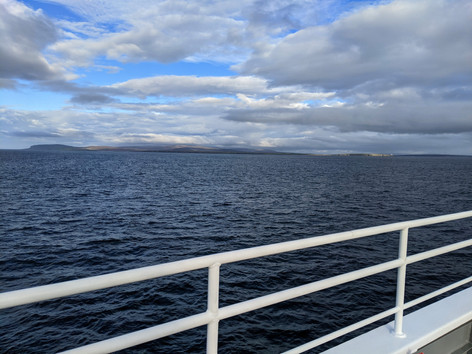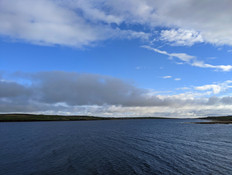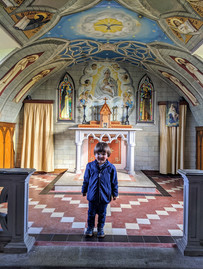Discover Your Backyard – The Orkney Islands (Days 1 & 2)
- Barry Pickard

- Oct 25
- 10 min read

Disclosure: This post contains affiliate links. Regardless of this, please be advised that all opinions expressed in this blog post are genuine and authentically my own.
Author: Barry Pickard
Hi, I'm Barry, the owner of Tailor-Made Itineraries and I have been designing bespoke self-guided tours for adventurous and curious travellers since 2015. I am a history graduate with a passion for travel.
I created this blog to show, through my own adventures, how you can have an incredible travel experience as an independent traveller, giving you the information to navigate the world with confidence.
Contents
Scapa Crafts
How do you make the most of your first two days in Orkney when every turn reveals another hidden treasure? The gentle thrum of ferry engines fades as you dock at St. Margaret's Hope, replaced by the crisp bite of island air carrying hints of sea salt and wild heather. Gulls call overhead while the crunch of harbour gravel underfoot signals the start of something special—your introduction to islands where Viking sagas come alive and Italian prisoners of war left behind chapels that'll bring tears to your eyes.

I'm Barry Pickard, and I've been crafting bespoke Scottish adventures for independent travellers since 2015. My four-day Orkney expedition started with two days that completely exceeded my expectations—from stumbling across world-class artisan distilleries to discovering that the islands harbour more creative talent per square mile than anywhere I've visited. You'll get my tested first-day route from ferry to accommodation, plus insider tips on everything from whisky tastings to finding those craft workshops that aren't in the guidebooks.

This is the beginning of my Orkney story—your complete guide to those crucial first 48 hours when you're still pinching yourself that places like this actually exist just off Scotland's coast.

Don’t forget that Tailor-Made Itineraries delights in creating bespoke self-guided tours. So, if visiting any of these attractions appeals to you, reach out to me by email. I would be more than happy to design a self-guided tour around your requirements incorporating the wonderful sights of Orkney, or indeed, a general tour of Scotland itself.
MV Alfred
Our trip started by taking the ferry from Gills Bay (near John O’Groats) to the small harbour of St. Margaret’s Hope on the island of South Ronaldsay, Orkney. We were the guests of Pentland Ferries, who operate the brand new purpose-built car and passenger ferry, the MV Alfred, which sails the Pentland Firth between the mainland and Orkney three times a day.
The voyage only takes one hour and thankfully the sea was calm as a mill pond. This was a bonus, since this stretch of water, where the North Atlantic and the North Sea clash, can be quite rough at times. Ythan was mesmerised with the whole trip and we watched from the outside upper deck as we sailed into Scapa Flow, the historic waterway which was once the home for the British Grand Fleet.
Hoxa Tapestry Gallery
Our first destination on landing at St. Margaret’s Hope was the hamlet of Hoxa, and, in particular, the Hoxa Tapestry Gallery. This family run gallery was established in 1996 to exhibit their large and unique handwoven tapestries. They must be a talented family since the son and daughter have now added their rugs and paintings to the gallery’s portfolio! It seemed during our time in Orkney that there is a disproportionate number of arts and crafts studios on the Orkney islands. These beautiful, rugged isles seem to fire the creative spirits of the islanders.
The Churchill Barriers
We then drove to the Mainland of Orkney, hopping from one island to another until reaching the largest island of the Orkney group. This didn't involve more ferries, because thankfully South Ronaldsay, Burray, Lamb Holm and Glimps Holm are actually joined to the Orkney Mainland by the Churchill Barriers.
Following the sinking of HMS Royal Oak by a German U-boat in October 1939, which resulted in the loss of 834 lives, the then First Lord of the Admiralty, Winston Churchill, ordered the building of the Churchill Barriers to block off the eastern approaches to the naval anchorage of Scapa Flow. Much of the labour for this massive engineering project was provided by Italian prisoners of war. It is also possible to see the wrecks of blockships as you drive over these artificial causeways. These outdated ships were purposely scuttled to block the channels while the barriers were being constructed.
If you are enjoying this post, remember and subscribe to my mailing list to receive my latest blog posts.
Rockworks Chalets
Immediately on arriving at the Mainland, we had reached our accommodation for our stay – the Rockworks Chalets in St. Mary’s. This was an ideal base for our adventures, and we felt very comfortable during our stay (click here to read our blog post review of Rockworks Chalets).
The Italian Chapel
After unpacking the car, we were back on the road exploring. The first stop – The Italian Chapel – wasn’t actually that far, since we could see it from our accommodation. It is hard to emphasise enough how delightful this small chapel is, and when you combine its beauty with the heart-rending back story to its construction, it possibly makes The Italian Chapel the must see place to visit in Orkney.
The Italian Chapel consists of two Nissen huts transformed into a beautiful chapel by Domenico Chiocchetti and his colleagues, Italian prisoners of war captured in North Africa and transported to the Island of Lamb Holm in Orkney. A shortage of manpower to construct the Churchill barriers coincided with the capture of thousands of Italian soldiers fighting in North Africa, so a decision was taken to transport 550 men to Camp 60 on Lamb Holm and a similar number to Camp 34 on Burray. Following a request from the camp priest, Fr Giacobazzi, it was agreed that two Nissen huts would be joined together to provide a chapel. Among the Italians in Camp 60 was an artist, Domenico Chiocchetti, and he was given the task of transforming the two Nissen huts into a chapel. He was assisted by other tradesmen - in particular, Giuseppe Palumbi, a blacksmith, and Domenico Buttapasta, a cement worker.
When the prisoners eventually left the island on 9 September, 1944, Chiocchetti remained behind to finish the font, which he was then occupied in making. After the war, the people of Orkney so cherished their chapel, that Domenico was invited back to visit in 1960, and he even restored the paint work while he was there!
The Orkney Wine Company
While on the island of Lambs Holm, we also visited The Orkney Wine Company. This family business produces handcrafted fruit wine and liqueurs, using 100% natural ingredients. It would have been rude not to buy anything while there, so we purchased a bottle of their delicious Special Reserve Raspberry Liqueur and we would definitely recommend it.
The Deerness Distillery
Keeping on the drinks theme, we then took a fifteen minute drive to the Deerness Distillery, which produces handcrafted multi award winning gin, vodka, and liqueurs. From a purpose-built distillery at the side of the founders’ home, they launched their products back in May 2017 and they now also conduct tours of their facility (although these tours weren’t currently available due to the Covid restrictions).
We tried samples of their ‘Sea Glass Gin’ and ‘Scuttled Gin’, but it was their ‘Orcadian Moon’ coffee liqueur that really captured the attention of our tastebuds. So again, we had to buy a bottle for later just to make sure that our initial perception was correct! A word of warning though – the distillery cat is very friendly and, you may find it difficult to coax it out of your car if you leave your door open for too long!
If you are enjoying this post, remember and subscribe to my mailing list to receive my latest blog posts.
The Gloup
While on the Deerness Peninsula, we made one last stop before heading back to the chalet, visiting The Gloup. This spectacular sounding feature is a dramatic collapsed sea-cave separated from the sea by a land bridge about 80 yards wide. It drops down around 80 feet, with the sea still crashing in through the blow hole. The name comes from the Old Norse "gluppa" - a chasm.
The Scapa Distillery
Our second day started at the Scapa Distillery, where we had booked a whisky tasting. By now, you are probably seeing a pattern emerging – Orkney has an amazing collection of distilleries, creating all sort of excellent spirits, and there are even two breweries. Orkney is a drink lovers paradise!
The Scapa Distillery creates an artisanal single malt forged by the extreme elements of Orkney. Water for the mashing comes from the Orquil Springs and the rugged climate means less spirit is lost to evaporation. Unlike other island distilleries no peat is used to dry their malt; this allows the uniquely sweet and tropical flavours of Scapa to come through. Tours of the distillery will be available once the pandemic restrictions pass, but in the meantime, I got to try four different varieties of the distillery’s single cask editions. All were excellent, but I’d have to say that the 13 year, at 61.6% vol was a little too strong to have more than a nip at one sitting. Pamela had drawn the short straw and was driving, but she was able to take away her samples and enjoy them over the next couple of evenings.

While at the distillery, make sure that you check out the back of the site, where you will get some beautiful views of Scapa Bay.

Scapa Crafts
Our next stop was Scapa Crafts, which is nestled in a residential area of Kirkwall, the main town on the Orkney Islands. Scapa Crafts are makers of traditional Orkney chairs, which have been at the heart of island homes for centuries. Traditionally made from driftwood found on the shoreline, their distinctive oat straw backs, often hooded, provided shelter from the draughts in old stone croft houses. Ythan loved trying out the chairs for size and we even got to see the craftsman himself weaving one of the chairs.
If you are enjoying this post, remember and subscribe to my mailing list to receive my latest blog posts.
St. Magnus Cathedral
We then headed into Kirkwall proper, seeking out the imposing St Magnus Cathedral. The cathedral is built from red and yellow sandstone in a Romano-Gothic style, and took about 300 years to build, the foundations starting in 1137. It was dedicated to Magnus Erlendsson, Earl of Orkney who was martyred on the island of Egilsay. Take note of the opening times since the cathedral was on restricted hours when we visited and make sure to set aside at least half an hour to check out the stunning interiors and the atmospheric graveyard. In particular, we were really taken by the fascinating and detailed stone memorials that lined the walls within the cathedral.
The Bishop’s and Earl’s Palaces
Opposite the cathedral is the Bishop’s and Earl’s Palaces. Unfortunately, these will not be open till next year, however, you can still study these well-preserved buildings from the medieval era as you walk through the grounds.
The Orkney Museum
Also opposite the cathedral, on Broad Street, is Tankerness House, which houses the Orkney Museum. Opening hours are also restricted to the museum, but we were still able to learn about the story of Orkney, from the Stone Age, to the Picts and Vikings, right through to the present day and it is well worth a look.
If you are enjoying this post, remember and subscribe to my mailing list to receive my latest blog posts.
Conclusion
As I settled into my chalet on that second evening, sharing drams of Orcadian Moon coffee liqueur and planning the adventures ahead, I realized these opening two days had set the perfect tone for our Orkney journey. I'd experienced the islands' incredible creativity (from tapestries to traditional chairs), tasted their world-class spirits, and been moved by the touching story of the Italian Chapel. What struck me most was the warmth of every islander we'd met—from distillery staff happy to share their craft to the friendly cat at Deerness who clearly runs the place. I'd covered impressive ground too, island-hopping via the Churchill Barriers and getting my bearings in Kirkwall, but it never felt rushed. The beauty of these first two days lies in how they whet your appetite for everything that's still to come. By day two's end, I wasn't just visiting Orkney anymore—I was beginning to understand why people fall in love with these remarkable islands and never quite want to leave.

Accommodation Suggestions
Orkney’s accommodation scene is as varied as its landscapes — from boutique hotels with harbour views, to cosy B&Bs in Kirkwall, to self-catering cottages and remote hostels tucked into quieter parts of the islands.
✨ Luxury / Premium Option
The Kirkwall Hotel - A classic waterfront hotel in the heart of Kirkwall, combining Victorian charm with modern comforts. It’s ideal if you want to be steps away from restaurants, shops and harbour life, while having a polished base to return to after long days of wandering.
The Sands Hotel, Burray - If you don’t mind being a little off the beaten track (but still connected), this boutique hotel in Burray offers sea views, quiet ambience, and a sense of being in an Orkney village rather than in Kirkwall itself.
💼 Mid-Range / Comfortable Picks
The Albert Hotel, Kirkwall - Situated right in the heart of Kirkwall, it offers contemporary boutique rooms with all your essentials. It’s a solid mid-tier choice when you want good location plus a bit more style.
🛏️ Budget / Value & Character Stays
West End Guest House, Kirkwall - A welcoming guesthouse located in Kirkwall, offering simple but clean rooms and reasonable pricing. It’s ideal if you want to be in town without spending for hotel luxury.
Booking Tips & Summary
Book early, especially in summer, because options outside Kirkwall are limited.
Location trade-off: Staying in Kirkwall gives you convenience, but coastal or rural options can offer more peace, views, and character.

Related Blog Posts
If you are interested in finding out more about the Orkney Islands, please view the Tailor-Made Itineraries posts below:
Share your own first impressions of Orkney or tell me which island attraction has you most intrigued—I'd love to hear about your Orkney dreams!
Don’t forget that Tailor-Made Itineraries delights in creating bespoke self-guided tours. So, if visiting any of these attractions appeals to you, reach out to me by email. I would be more than happy to design a self-guided tour around your requirements incorporating the wonderful sights of Orkney, or indeed, a general tour of Scotland itself.
Tailor-Made Itineraries posts every two weeks, and you can subscribe to the latest blog and newsletter here. Until then, happy reading and safe travels.
Barry
Contact Me: tailoritineraries@gmail.com
Tailor-Made Itineraries creates one-of-a-kind bespoke self-guided travel itineraries for adventurous and curious travellers.
These self-guided tours deliver a personalised and exciting holiday experience that takes the effort out of trip planning.
Map of Orkney















































































































































































Comments